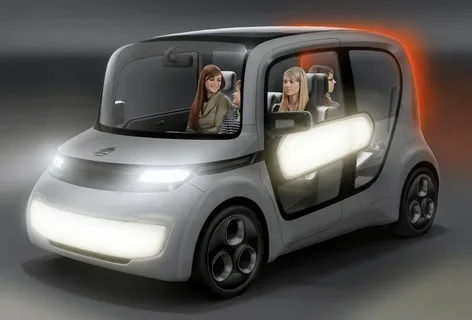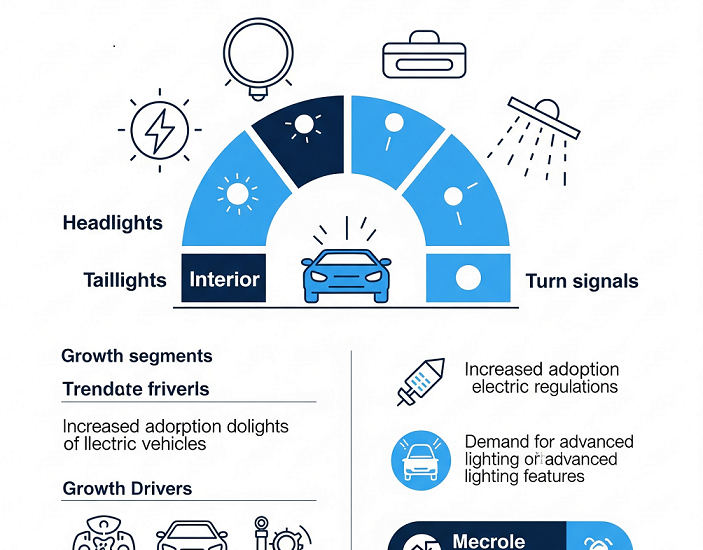The global EV lighting market is estimated at USD 4.1 billion in 2025 and further projected to reach USD 21.8 billion by 2035, reflecting a compound annual growth rate (CAGR) of 21.7% over the forecast period. Market expansion is being supported by the growing integration of intelligent lighting systems as a core feature of next-generation electric vehicles.
Electric vehicles have captured the world’s imagination with their whisper-quiet motors, aerodynamic designs, and digitally integrated dashboards. But beneath the sleek styling and smart tech lies one of the most powerful tools for safety, identity, and communication: the lighting system.
Often reduced to styling flair or compliance checkboxes, EV lighting plays a much more profound role in the way electric vehicles operate and interact with the world around them. As mobility becomes cleaner and quieter, lighting has emerged as a critical interface between the vehicle, its environment, and the people it shares the road with.
Get Ahead with Our Report: Request Your Sample Now!
https://www.futuremarketinsights.com/reports/sample/rep-gb-16571
More Than a Headlight: The Language of Light
Unlike internal combustion vehicles, EVs are virtually silent at low speeds—creating new safety challenges for pedestrians, cyclists, and other drivers. Lighting, in this context, becomes more than illumination; it becomes a voice. From animated DRLs (daytime running lights) to dynamic turn signals and smart ambient cues, EV lighting systems help vehicles “speak” in ways that sound never could.
For autonomous and semi-autonomous vehicles, the importance of visual signaling only grows. Lighting systems are beginning to indicate intent—when a vehicle is yielding, braking, or about to re-enter traffic—all of which demand precise coordination and real-time responsiveness.
Overshadowed in the Race for Range
While battery chemistry and drivetrain efficiency dominate headlines, lighting often takes a backseat in the EV conversation. Yet, modern lighting systems are deeply intertwined with range and performance. Every watt counts in an electric vehicle, and inefficient lighting translates directly into lost mileage.
This is why the shift toward adaptive LED and laser-based systems isn’t just aesthetic—it’s functional. Smarter lighting reduces energy draw, adjusts to ambient conditions, and enhances visibility while minimizing power loss. But not all OEMs invest equally in these advancements, creating a silent disparity in performance and safety.

Material Demands in a Lightweight Era
EV platforms are obsessed with weight reduction and aerodynamic purity. That means lighting components—once bulky and heat-intensive—must now be compact, lightweight, and seamlessly integrated into vehicle design. The challenge? Achieving thermal management, optical clarity, and rugged durability in an increasingly unforgiving package.
Suppliers must now innovate not just in light output, but in housing design, mounting systems, and materials that can survive harsh weather, vibration, and temperature swings without adding mass or reducing recyclability.
Connected, Adaptive, and Under Pressure
EV lighting isn’t static anymore. Systems now respond to inputs from cameras, sensors, and vehicle control units. High-beam assist, cornering lights, adaptive projections—they all rely on software-controlled logic. This makes EV lighting a functional part of the vehicle’s nervous system, constantly adapting to road conditions, speed, and driver behavior.
But this complexity also raises the stakes. A glitch in lighting software can compromise visibility, confuse other drivers, or even fail regulatory standards. Ensuring seamless integration with vehicle electronics and cybersecurity protocols is now as important as the light source itself.
Exhaustive Market Report: A Complete Study
https://www.futuremarketinsights.com/reports/ev-lighting-market
Lighting the Path Forward
The next frontier for EV lighting goes beyond illumination—it’s about interaction. Expect to see more vehicle-to-pedestrian lighting cues, customizable lighting signatures for brand identity, and modular units that update over time via software. Lighting is fast becoming one of the most emotionally resonant and functionally critical parts of EV design.
OEMs must treat lighting not as a design afterthought, but as a strategic pillar in the user experience, safety profile, and energy optimization of every electric vehicle they launch.
The Hidden Power of Visibility
Underestimate lighting, and you risk dulling the safety and personality of your EV. Embrace it, and it becomes a powerful differentiator—enhancing trust, reducing accidents, and elevating the user experience in subtle but transformative ways.






